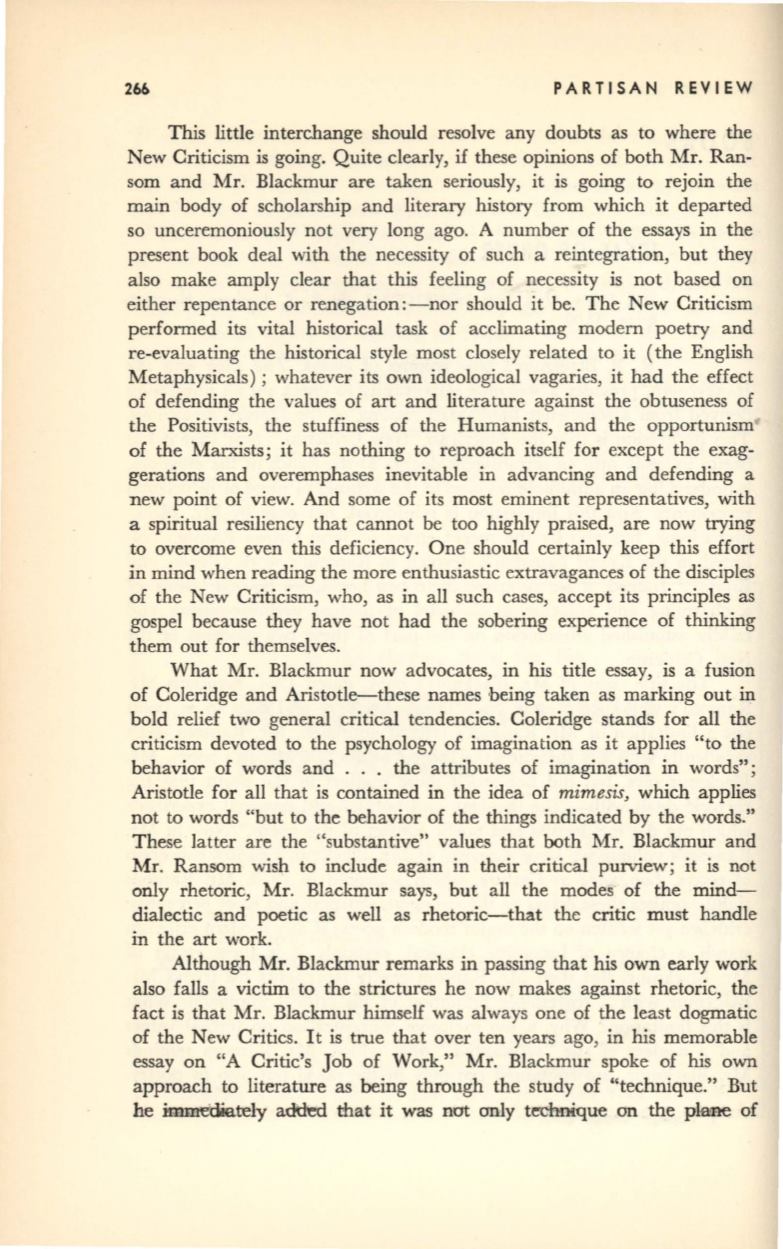
266
PARTISAN REVIEW
This little interchange should resolve any doubts as to where the
New Criticism is going. Quite clearly, if these opinions of both Mr. Ran–
som and Mr. Blackmur are taken seriously,
it is going
to rejoin the
main body of scholarship and literary history from which it departed
so unceremoniously not very long ago. A number of the essays in the
present book deal with the necessity of such a reintegration, but they
also make amply clear that this feeling of necessity is not based on
either repentance or renegation:-nor should it be. The New Criticism
performed its vital historical task of acclimating modern poetry and
re-evaluating the historical style most closely related to it (the English
Metaphysicals) ; whatever its own ideological vagaries, it had the effect
of defending the values of art and literature against the obtuseness of
the Positivists, the stuffiness of the Humanists, and the opportunism
of the Marxists; it has nothing to reproach itself for except the exag–
gerations and overemphases inevitable in advancing and defending a
new point of view. And some of its most eminent representatives, with
a spiritual resiliency that cannot be too highly praised, are now trying
to overcome even this deficiency. One should certainly keep this effort
in
mind when reading the more enthusiastic extravagances of the disciples
of the New Criticism, who, as in all such cases, accept its principles as
gospel because they have not had the sobering experience of thinking
them out for themselves.
What Mr. Blackmur now advocates, in his title essay, is a fusion
of Coleridge and Aristotle-these names being taken as marking out in
bold relief two general critical tendencies. Coleridge stands for all the
criticism devoted to the psychology of imagination as
it
applies "to the
behavior of words and ... the attributes of imagination in words";
Aristotle for all that is contained
in
the idea of
mimesis,
which applies
not to words "but to the behavior of the things indicated by the words."
These latter are the "substantive" values that both Mr. Blackmur and
Mr. Ransom wish to include again in their critical purview; it is not
only rhetoric, Mr. Blackmur says, but all the modes of the mind–
dialectic and poetic as well as rhetoric-that the critic must handle
in the art work.
Although Mr. Blackmur remarks in passing that his own early work
also falls a victim to the strictures he now makes against rhetoric, the
fact is that Mr. Blackmur himself was always one of the least dogmatic
of the New Critics. It is true that over ten years ago, in his memorable
essay on "A Critic's Job of Work," Mr. Blackmur spoke of his own
approach to literature as being through the study of "technique." But
he imme'die.tely added that it was not only technique on the plane of


